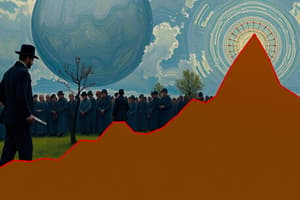Podcast
Questions and Answers
The unemployment rate measures:
The unemployment rate measures:
- Unemployed workers as a percentage of the population age over sixteen.
- Unemployed workers as a percentage of the labor force. (correct)
- Unemployed workers as a percentage of the population.
- The number of people unemployed divided by the number of people employed.
During the Great Depression of the 1930s, the unemployment rate reached more than:
During the Great Depression of the 1930s, the unemployment rate reached more than:
- 85 %
- 25 % (correct)
- 65 %
- 45 %
Reginald looked for work for six months but could not find a job to his liking. He now spends time at the beach. For purposes of employment, he is considered:
Reginald looked for work for six months but could not find a job to his liking. He now spends time at the beach. For purposes of employment, he is considered:
- Employed in the underground economy.
- Unemployed.
- Out of the labor force. (correct)
- Underemployed.
Over time, the unemployment rate in the U.S. seems to return to a range of:
Over time, the unemployment rate in the U.S. seems to return to a range of:
If the unemployment rate is 8 percent, this means:
If the unemployment rate is 8 percent, this means:
A welder who quits his job and moves from Pittsburgh to Madison to try to get a better welding job is said to be:
A welder who quits his job and moves from Pittsburgh to Madison to try to get a better welding job is said to be:
Frictional unemployment is:
Frictional unemployment is:
The type of unemployment that occurs because of a recession is called:
The type of unemployment that occurs because of a recession is called:
The definition of market equilibrium states that at the equilibrium wage, the quantity of labor demanded by employers will equal the quantity supplied. This is referred to as:
The definition of market equilibrium states that at the equilibrium wage, the quantity of labor demanded by employers will equal the quantity supplied. This is referred to as:
The rise in unemployment that occurs because of a recession is known as cyclical unemployment, because it is closely tied to the:
The rise in unemployment that occurs because of a recession is known as cyclical unemployment, because it is closely tied to the:
The most significant real economic cost of high unemployment is:
The most significant real economic cost of high unemployment is:
Karen chooses to go to university full-time rather than to work. Karen:
Karen chooses to go to university full-time rather than to work. Karen:
The theory that argues that the productivity of workers will increase if more is paid to them, and so employers will often find it worthwhile to pay their employees somewhat more than market conditions might dictate is:
The theory that argues that the productivity of workers will increase if more is paid to them, and so employers will often find it worthwhile to pay their employees somewhat more than market conditions might dictate is:
Cyclical unemployment arises when:
Cyclical unemployment arises when:
Frictional unemployment occurs when:
Frictional unemployment occurs when:
A forestry worker who is out of work because of the temporarily low demand for wood products associated with a recession is defined as:
A forestry worker who is out of work because of the temporarily low demand for wood products associated with a recession is defined as:
Insofar as government public policy is concerned, the best way to battle unemployment would be:
Insofar as government public policy is concerned, the best way to battle unemployment would be:
The labor force consists of:
The labor force consists of:
Flashcards are hidden until you start studying
Study Notes
Unemployment Rate Definitions and Measures
- The unemployment rate is calculated as the percentage of unemployed workers in the labor force.
- During the Great Depression, the unemployment rate exceeded 25% of the labor force.
- Individuals like Reginald, who are not actively seeking jobs, are classified as out of the labor force.
Economic Trends and Unemployment
- U.S. unemployment rates fluctuate with economic cycles, often returning to a range of 4-6% over time.
- An 8% unemployment rate indicates that 8% of the labor force is unemployed, not the total population.
Types of Unemployment
- Frictional unemployment occurs when workers voluntarily leave jobs to seek better opportunities.
- Structural unemployment results from mismatches in skills and job requirements or lack of training.
- Cyclical unemployment is linked to economic recessions and declines in business activity.
Labor Market Concepts
- Market equilibrium occurs when the quantity of labor demanded equals the quantity supplied at the equilibrium wage.
- The rise in unemployment during a recession is a reflection of the business cycle.
Economic Costs of Unemployment
- The most significant economic cost of high unemployment includes potential goods and services not produced.
- Additional costs may stem from retraining efforts for unemployed individuals and loss of tax revenue.
Labor Force Composition
- The labor force comprises adults who are either employed or actively seeking work, excluding discouraged workers.
- Government policies aimed at minimizing recessions are viewed as effective strategies for reducing unemployment.
Theories and Dynamics
- Efficiency wage theory suggests that productivity may increase if employers pay higher wages, even beyond market conditions.
- Frictional unemployment is also described as individuals quitting their current jobs to pursue different opportunities.
Definition of Key Terms
- Cyclical Unemployment: Arises from downturns in economic activity.
- Frictional Unemployment: Occurs due to natural labor market turnover.
- Natural Rate of Unemployment: The normal level of unemployment in an economy independent of short-term fluctuations.
- Equilibrium Wage: The wage at which labor supply equals labor demand.
Studying That Suits You
Use AI to generate personalized quizzes and flashcards to suit your learning preferences.




